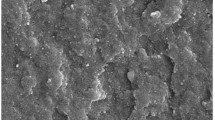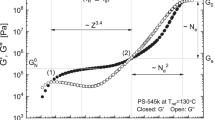Summary
Viscosities of particle filled polymer melts were measured at fairly low shear rate. Particles were glass beads, glass balloons, and silas balloons. Polymers were polyethylene and polystyrene. Flow curves were superimposed with respect to concentration of filler. The relative viscosity defined as the ratio of viscosity of filled polymer to that of unfilled polymer at the same shear stress is obtained as an asymptotic value even for highly filled material. The relation between relative viscosity and volume fraction of filler was represented by the equations derived byMaron andPierce orMooney. Only the distribution of particle size had influence on relative viscosity at a defined filler concentration. Yield stresses were estimated, and found to increase exponentially in the range of volume fraction from 0.1 to 0.5.
Zusammenfassung
Viskositäten von Polymerschmelzen, die mit Teilchen gefüllt worden waren, wurden bei mittleren Schergeschwindigkeiten bestimmt. Als Teilchen wurden Voll- und Hohlkugeln aus Glas, sowie sog. „silas balloons“, als Polymere Polyäthylen und Polystyrol verwendet. Die Fließkurven für verschiedene Füllstoffkonzentrationen wurden überlagert. Die relative Viskosität, definiert als das Verhältnis der Viskositäten von gefülltem und ungefülltem Polymer bei gleicher Schubspannung, besitzt einen asymptotischen Wert selbst für hoch gefülltes Material. Die Beziehung zwischen relativer Viskosität und Füllstoff-Volumenkonzentration läßt sich durch eine vonMaron undPierce oder eine vonMooney abgeleitete Gleichung beschreiben. Nur die Teilchengrößenverteilung hat bei einer definierten Füllstoffkonzentration einen Einfluß auf die relative Viskosität. Fließspannungen werden abgeschätzt und dafür in einem Konzentrationsbereich zwischen 0,1 und 0,5 ein exponentieller Anstieg gefunden.
Similar content being viewed by others
References
Isahaya, Y., K. Kimura, K. Jinnai Kogyo Zairyo19, 84 (1971).
Kataoka, T., S. Ueda, R. Onooka, K. Nishijima Kobunshi Kagaku (“Chemistry of High Polymer” in Japan)30, 260 (1973).
Kataoka, T., K. Nishijima Kobunshi Ronbunshu32, 501 (1975).
Matsumoto, T., A. Takashima, T. Masuda, S. Onogi Trans. Soc. Rheology14, 617 (1970).
Mills, N. J. J. Appl. Polym. Sci.15, 2791 (1971).
Nicodemo, L., L. Nicolais J. Appl. Polym. Sci.18, 2809 (1974).
Dubois, D., D. Dubos, G. Evrard Rheol. Acta13, 658 (1974).
Angerer, G., D. Wolff Rheol. Acta15, 57 (1976).
Maron, S. H., P. E. Pierce J. Colloid Sci.11, 80 (1956).
Mooney, M. J. Colloid Sci.6, 162 (1951).
Thomas, D. G. J. Colloid Sci.20, 267 (1965).
Cross, M. M. Rheol. Acta14, 402 (1975).
Casson, N. in:C. C. Mill (ed.), Rheology of Disperse Systems, p. 84 (Pergamon Press, London 1959).
Author information
Authors and Affiliations
Additional information
With 13 figures and 2 tables
Rights and permissions
About this article
Cite this article
Kataoka, T., Kitano, T., Sasahara, M. et al. Viscosity of particle filled polymer melts. Rheol Acta 17, 149–155 (1978). https://doi.org/10.1007/BF01517705
Received:
Issue Date:
DOI: https://doi.org/10.1007/BF01517705




